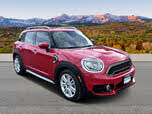2020 MINI Countryman vs 2019 Toyota 4Runner
Overview | ||
MSRP | $35,310 | $28,400 |
Average price | $33,718 | $20,137 |
Listings | ||
Ratings & Reviews | ||
User reviews | ||
Expert reviews | 7.2 out of 10Read full review | |
Pros & cons | Pros
| |
Summary | If you’re in the market for a modern SUV capable of getting off the beaten path, you have only a handful of options. These include the 2- and 4-door Jeep Wranglers, the Jeep Cherokee Trailhawk, the Jeep Grand Cherokee Trailhawk, the Land Rover Range Rover, and the Toyota 4Runner. Of those, only the Jeep Wrangler Unlimited and the 4Runner are 4-door SUVs that put off-road grit above all else. While the Jeep Wrangler is only one year removed from a complete redesign that brought in many new technologies, the 2019 Toyota 4Runner is based on a design first introduced in 2009. For those keeping score at home, that means the DNA underpinning the 4Runner is a decade old. Yet picking which vehicle I’d choose as a daily drivable, off-road-capable SUV is a surprisingly difficult decision. So where does an old goat like the 2019 Toyota 4Runner fit in the modern SUV market? Interestingly, the 4Runner's advanced age actually helps it in some respects. | |
Video | No video found | |
Popular Features & Specs | ||
Engine | 4.0L 270 hp V6 | 1.5L 134 hp I3 |
Drive Train | 4X2 | FWD |
Seating Capacity | 7 | 5 |
Horsepower | 270 hp @ 5600 rpm | 134 hp @ 4400 rpm |
MPG City | 17 | 26 |
MPG Highway | 21 | 33 |
Engine | ||
Engine Name | 4.0L 270 hp V6 | 1.5L 134 hp I3 |
Torque | 278 lb-ft @ 4400 rpm | 162 lb-ft @ 1250 rpm |
Horsepower | 270 hp @ 5600 rpm | 134 hp @ 4400 rpm |
Drivetrain | 4X2 | FWD |
Fuel Economy | ||
MPG City | 17 | 26 |
MPG Highway | 21 | 33 |
Interior | ||
Seating Capacity | 7 | 5 |
Key Features | ||
Sunroof/Moonroof | Standard | |
Safety | ||
Front Crash Overall | 4 | |
Side Crash Overall | 5 | |
Dimensions & Capacity | ||
Cargo Space | 47.2 cu ft | 17.6 cu ft |
Curb Weight | 4400 lbs | 3300 lbs |
Height | 71.5 in | 61.3 in |
Length | 190.2 in | 169.8 in |
Width | 75.8 in | 78.9 in |
Wheelbase | 109.8 in | 105.1 in |
Maximum Payload | 1700 lbs | 860 lbs |
Number of doors | 4 | 4 |
Maximum Towing Capacity | 5000 lbs | |
Standard Towing Capacity | 5000 lbs | |

By: CarGurus + AI
At CarGurus, our team of experienced automotive writers remain at the heart of our content operation, conducting hands-on car tests and writing insightful guides that are backed by years of industry experience. To complement this, we are harnessing AI to make our content offering more diverse and more helpful to shoppers than ever. To achieve this, our AI systems are based exclusively on CarGurus content, ratings and data, so that what we produce is both unique to CarGurus, and uniquely helpful to car shoppers.




















